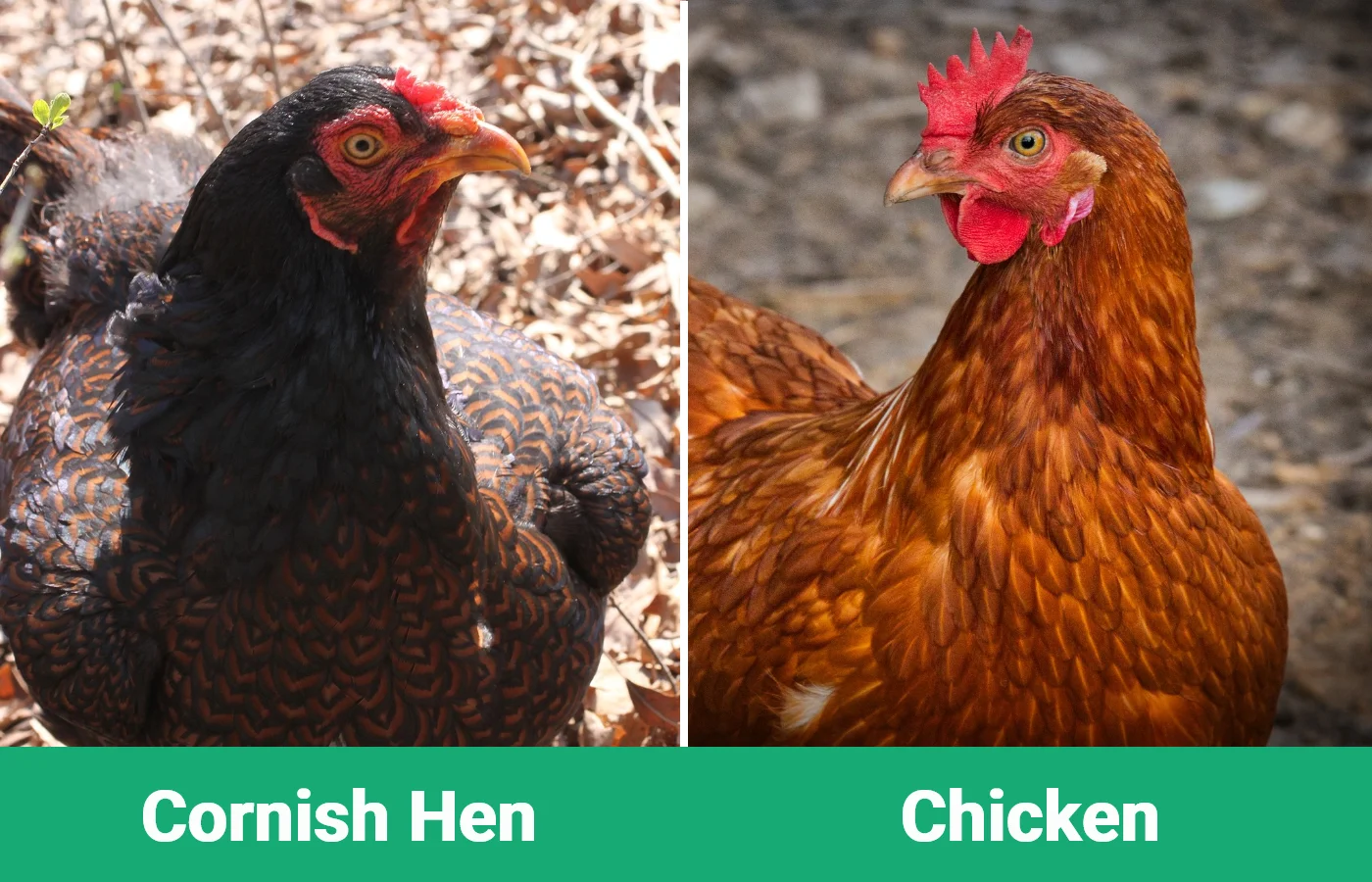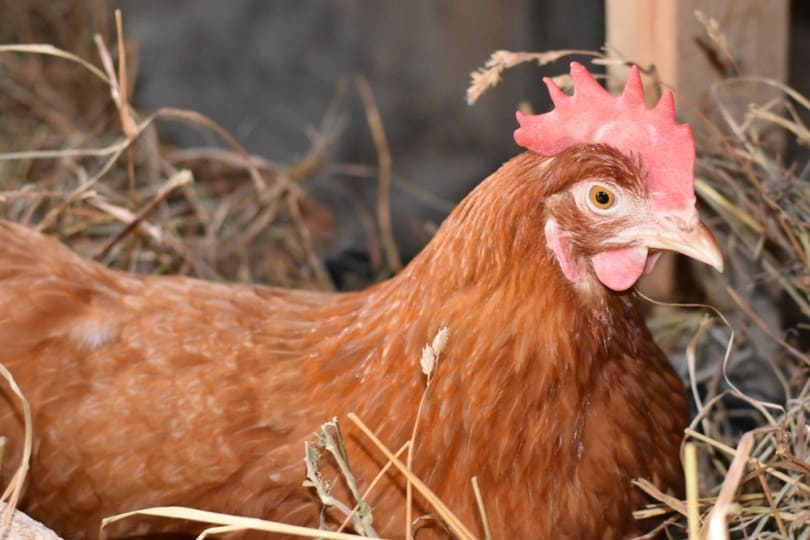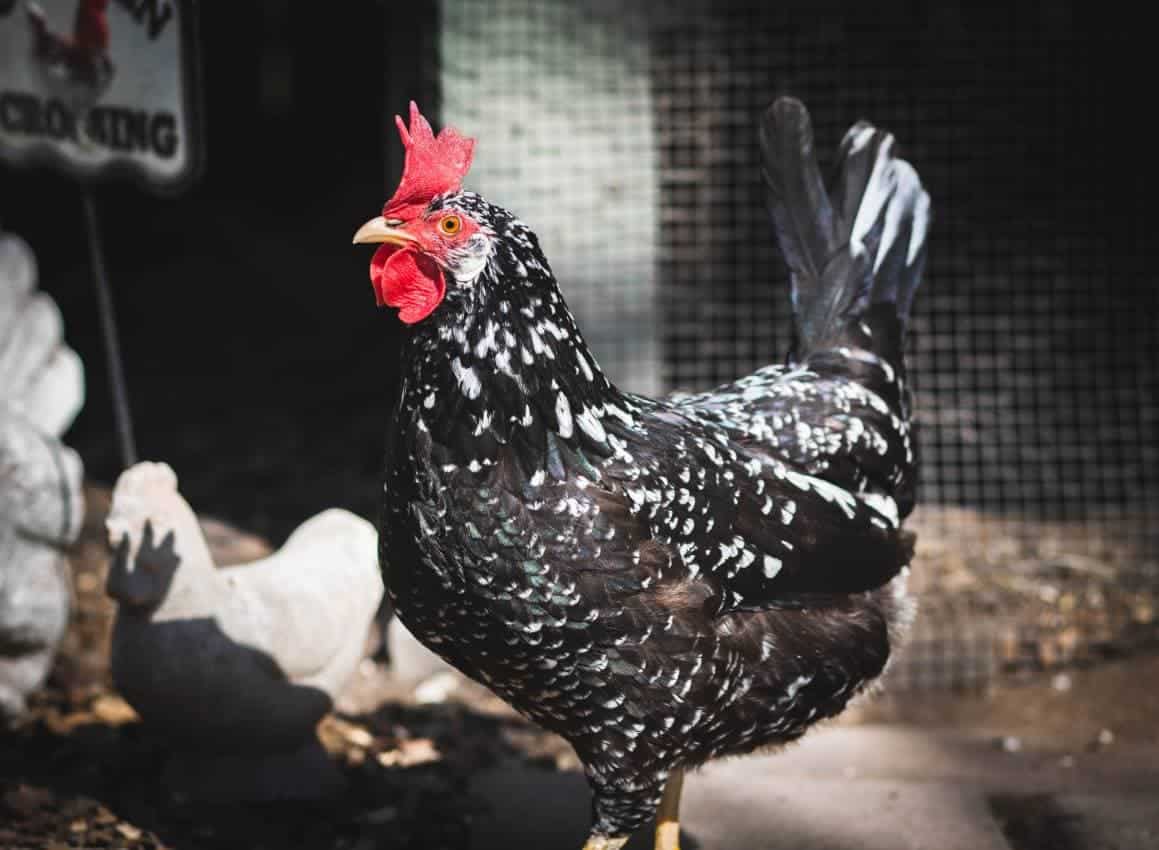Are you ready to put on your mud boots and toss a bucket of grain first thing in the morning? If you’re looking into possibly raising a flock of chickens or hens—you’re going to have some questions. One of the major things you have to decide is what kind of chickens you want and which needs they will meet.
If you have heard of Cornish or Cornish cross hens, it might strike your radar to look into them more. But what exactly is the breed all about and how they different from other chickens? Let’s take a closer look.

Visual Differences

At a Glance
- Origin: United Kingdom
- Size: 1 – 2 pounds
- Lifespan: 5 – 8 years
- Domesticated?: Yes
- Origin: Asia
- Size: 4 – 7 pounds
- Lifespan: 5 – 10 years
- Domesticated?: Yes

Cornish Hen Overview

When you think of a good feast, a Cornish hen probably comes to mind. These are the birds you see on kitchen tables, perfect for rotisserie chickens and crockpot meals. Cornish hens grow quickly and have short lifespans before their harvest.
If you own Cornish hens, you know the time spent with these creatures is quickly passing. You buy them as chicks, and they are ready to be butchered within just a couple of weeks. This type of hen is definitely a meat bird and is not suitable for layer flocks.
Characteristics & Appearance
Cornish hens are heavy, muscular chickens with a sleek feather structure. They are usually black or white with a scattered pattern. These birds are made for meat, so they gain weight quickly without slowing down.
Regulating their diets can be very challenging. They tend to put on weight quickly. Even when fed correctly, they are very muscular and stocky.

Uses
Cornish hens are meat chickens through and through. These hens weigh between 1 and 2 pounds at only 5 weeks, ready for slaughter. Because this breed gains weight rapidly, you must adhere to a strict culling schedule.
You might want a flock your kids can feed first thing in the morning until the sweet old ladies pass from natural aging. Other times, you want a batch of eggs to round up for today’s sale. No matter what the purpose is, if meat isn’t on your chicken to-dos, say no to the breed.
It isn’t advised that you keep Cornish hens as pets or for eggs. Because of how this breed develops, they would likely pass from heart failure within the first year of life.
Some Cornish hybrids can’t withstand even more than 10 weeks of life. Their bodies grow faster than their joints and bones, causing their legs to buckle. Sticking to the original plan is best if you opt for a flock of Cornish rocks or Cornish crosses.

Chicken Overview

A chicken is a broad category of a farm bird with tons of other breeds under its title. Chickens have become a staple in farm life—you can’t have a full house without them. These meat and egg producers are one of the highest-yielding farm animals you can have.
There are over 500 different breeds of chicken worldwide, and this number grows all the time. Constantly, breeders diligently try to produce new breed lines that serve farming purposes more efficiently.
Characteristics & Appearance
Chickens are flightless birds used for meat and egg production. These fowl stay in flocks, finding safety in numbers. These birds usually range in personality from docile to adventurous to aggressive.
All chicken breeds have their own distinguishing characteristics.
Giant
Some chickens can get downright massive, like the Jersey Giant. As the largest chicken breed, these monstrous but gentle creatures can weigh up to 13 pounds. Giant chickens tend to grow slower than smaller sizes.
Standard Size
The majority of chicken breeds are standard size. These breeds can be egg layers, dual-purpose, or meat chickens. The hens top out at roughly 5 pounds, and roosters can get up to 7 pounds.
Bantams
Bantams are the smallest group of chickens—and probably the feistiest. Many bantams are ornamental chickens, but some can be moderately decent layers. These chickens weigh between 1 and 3 pounds.

Uses
There is an abundance of different looks and purposes in the chicken world. Breeders have really gotten creative with breed lines, producing egg layers, meat chickens, and ornamental birds.
Meat
Some chickens are used strictly in meat production. They quickly gain body weight, producing ready-to-harvest specimens after just a few short weeks.
Eggs
Certain breeds are notoriously fantastic layers, producing upwards of 300 eggs per year—that’s nearly one a day!
Ornamental
Ornamental birds are bred for their charming, good looks and really not much else. They are bred for show, touting exotically beautiful feather patterns and interesting composition.

What Are the Differences Between Cornish Hens & Chickens?

If you’re new to poultry, you’re probably curious about all the different breeds—and for a good reason. Some chickens are skilled for certain benefits to suit us. Some chickens lay eggs, others enter the meat market, and some are just for looks.
Hens and chickens might sound like they’re not the same—but that isn’t the case. A hen is just another term for female chicken. Males are referred to as roosters. When they are chicks, you might hear the term cockerel for boys and pullet for girls.
There is no difference between a Cornish hen and a chicken. All Cornish hens are chickens, but not all chickens are Cornish hens—that’s a good way to remember. Cornish chickens are birds bred specifically for meat production.
The Cornish hen is just one of the hundreds of chicken breeds.

Which Breed Is Right For You?
If meat hens are right for you, Cornish chickens might be what takes up your yearly flock space. However, all Cornish hens are chickens—but there are also tons of breeds to check out that aren’t Cornish hens. You can get a mixed flock or specific breed that matches your needs.
Your first move here is deciding whether you want meat chickens, egg layers, a combination breed, or ornamental types.
See also:
Featured Image Credit: Top – Red Cornish Hen (Cindy Dillon, Shutterstock); Bottom – Chicken (Capri23auto, Pixabay)
